Would Sir like extra bombs with that?
Moderator: MOD_WarintheWest
T6
T6
Keeping to the same morale rules for the airforce. 22 BC squadrons set to rest and 7 from 8 AAF (3 of these the B-26s that hit Rostock (no surprise given their losses). In general, I'm happy with the combination of settings as its allowing me to keep a sustained bombing effort as opposed to having periods where most of the Strategic bombers need to rest.
Would like the VP position to improve a bit. Losing 2 per turn due to the U-boats is frustrating as I'd rather have that back to 1. Last turns BC raid was a waste.
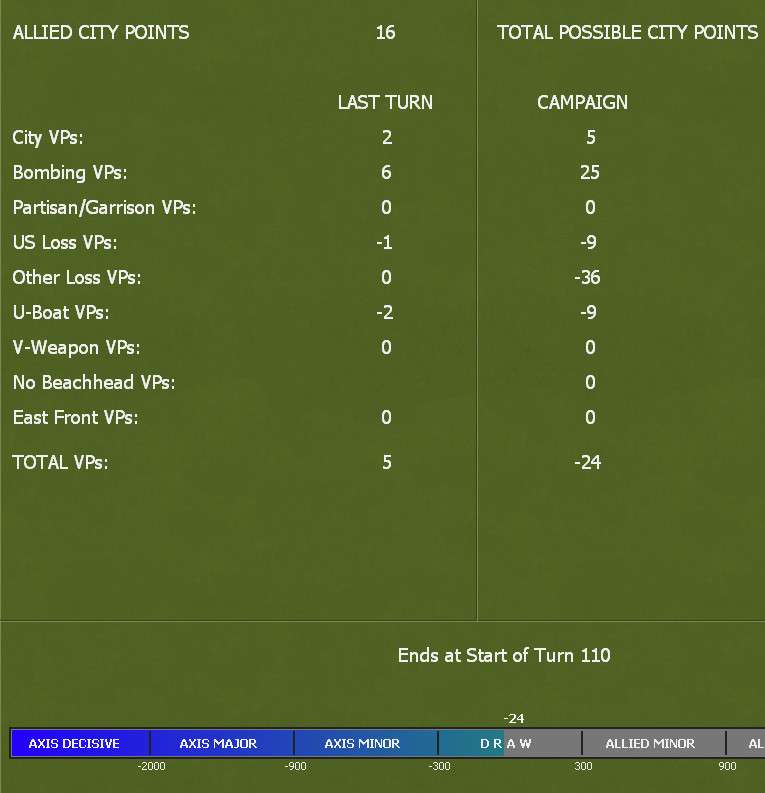
Decided to return BC to what it does best and hit the Ruhr again. Plenty of undamaged HI, fuel and manpower targets there. Split off some of the NF to run a night intruder mission since I have plenty of escorts available.
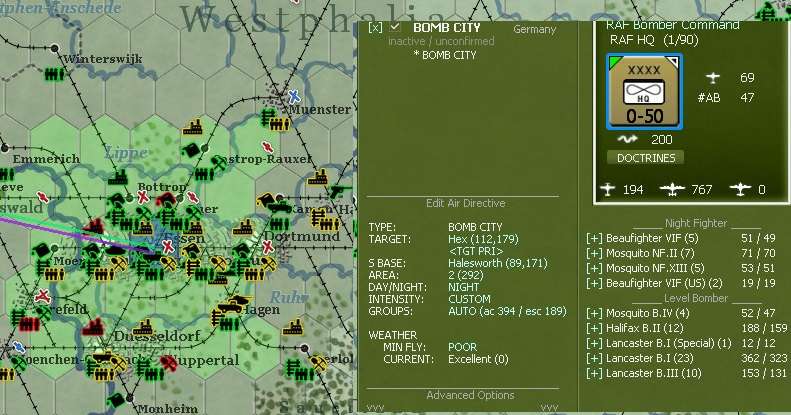
Decided to keep trying to knock out the U-boats at Luebeck with 8 AAF. Have converted some P-47 formations to P-38s which gives me escorts over the targets as well as on the approach.
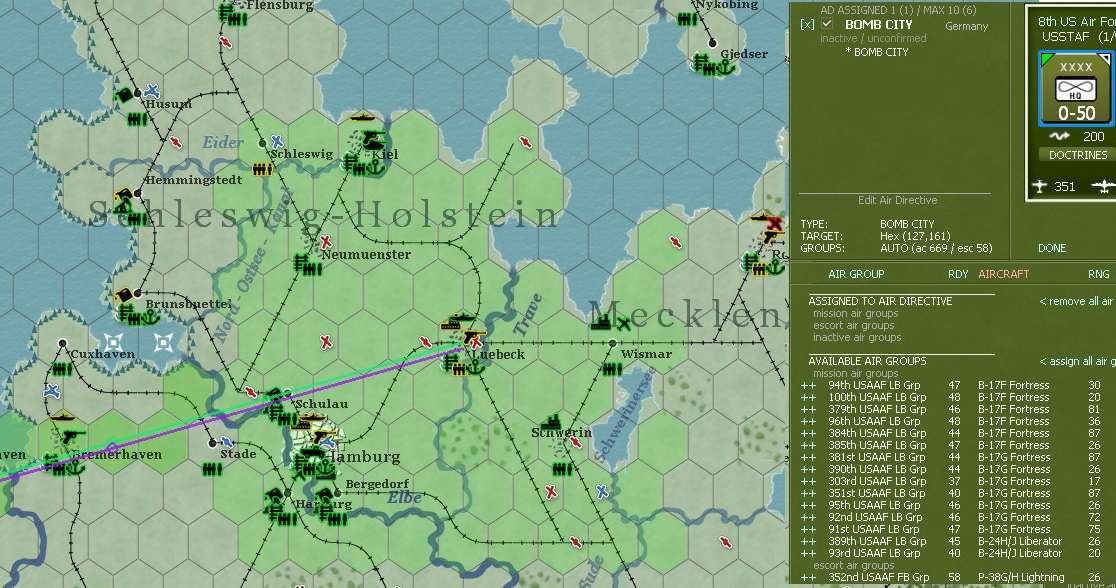
Picture of the overall Ruhr raids. Using the 2E bombers from Tactical Air to hit the smaller targets to the north of the Ruhr and the only useable B-26 formation on a raid aimed at Emmerich. Fighter Command running AS to try and catch the attention of the German fighters.
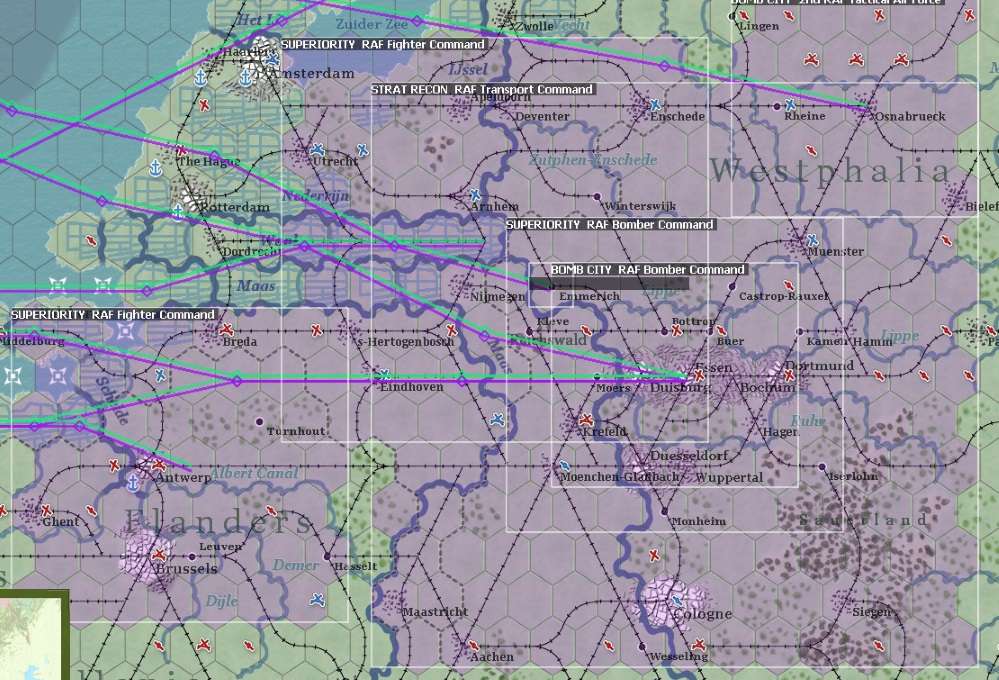
Italy. Still taking out the ports on Sardinia. Shifted to the main rail junctions and ports in S Italy. Land and Ground interdiction missions aimed at cutting off Messina. No real hurry here as I need to finish off the units I've cut off first.
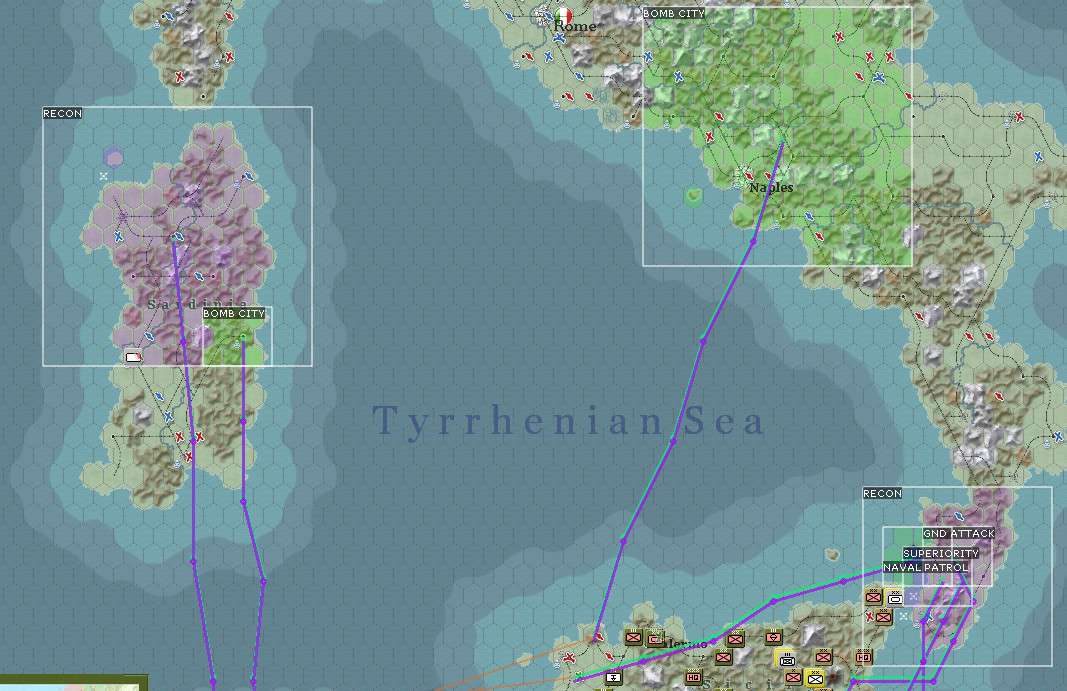
Bomber Command had a good week, even if it did decide to hit its own private target list rather than what is what ordered to do. The advantage of better targetting information over the Ruhr really does pay off.
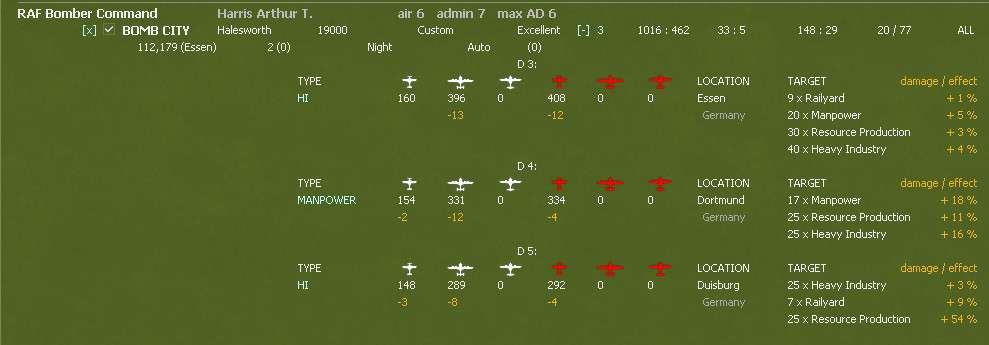
The localised raids by tactical air also paid off which more damaged manpower (in targets not really worth diverting the 4 engined bombers to).

8 AAF is proving strangely U-boat adverse but otherwise did a lot of damage and won its aerial battles. The small raid on Emmerich both did damage to the targets and chewed up the Luftwaffe (well within the range of the P-47s).
As an aside, in a PBEM, most German players would have their fighters set up out of range of the P-47s/Spitfires precisely to avoid this sort of losses.
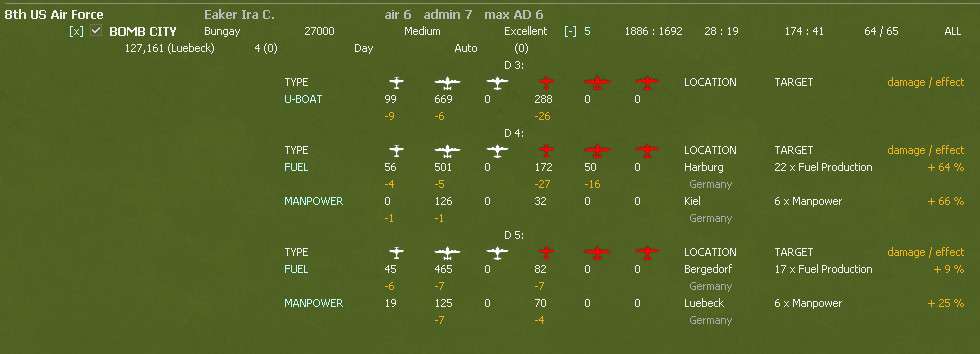
Interdiction results in Italy. In combination with the rail yard bombing, that will hurt any attempts at resupply or to retreat. Note I am deliberately avoiding hitting Messina and Reggio-Calabria due to the amount of flak there so as in N Europe the intent is to keep a steady stream of damage rather than risk everything on a big direct attack.
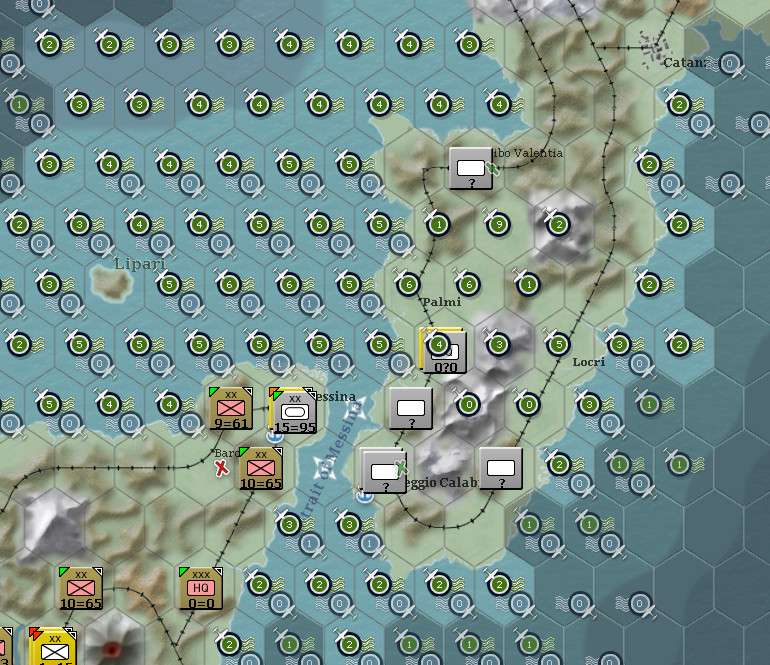
Sicily at the end of turn. Will finish off the last of the trapped units next turn then prepare to take Messina. I'm happy enough to take my time over this, not least the usage of airpower means it is costing the Germans a lot to cling on. Also am waiting for the next set of invasions to be ready.

Keeping to the same morale rules for the airforce. 22 BC squadrons set to rest and 7 from 8 AAF (3 of these the B-26s that hit Rostock (no surprise given their losses). In general, I'm happy with the combination of settings as its allowing me to keep a sustained bombing effort as opposed to having periods where most of the Strategic bombers need to rest.
Would like the VP position to improve a bit. Losing 2 per turn due to the U-boats is frustrating as I'd rather have that back to 1. Last turns BC raid was a waste.

Decided to return BC to what it does best and hit the Ruhr again. Plenty of undamaged HI, fuel and manpower targets there. Split off some of the NF to run a night intruder mission since I have plenty of escorts available.

Decided to keep trying to knock out the U-boats at Luebeck with 8 AAF. Have converted some P-47 formations to P-38s which gives me escorts over the targets as well as on the approach.

Picture of the overall Ruhr raids. Using the 2E bombers from Tactical Air to hit the smaller targets to the north of the Ruhr and the only useable B-26 formation on a raid aimed at Emmerich. Fighter Command running AS to try and catch the attention of the German fighters.

Italy. Still taking out the ports on Sardinia. Shifted to the main rail junctions and ports in S Italy. Land and Ground interdiction missions aimed at cutting off Messina. No real hurry here as I need to finish off the units I've cut off first.

Bomber Command had a good week, even if it did decide to hit its own private target list rather than what is what ordered to do. The advantage of better targetting information over the Ruhr really does pay off.

The localised raids by tactical air also paid off which more damaged manpower (in targets not really worth diverting the 4 engined bombers to).

8 AAF is proving strangely U-boat adverse but otherwise did a lot of damage and won its aerial battles. The small raid on Emmerich both did damage to the targets and chewed up the Luftwaffe (well within the range of the P-47s).
As an aside, in a PBEM, most German players would have their fighters set up out of range of the P-47s/Spitfires precisely to avoid this sort of losses.

Interdiction results in Italy. In combination with the rail yard bombing, that will hurt any attempts at resupply or to retreat. Note I am deliberately avoiding hitting Messina and Reggio-Calabria due to the amount of flak there so as in N Europe the intent is to keep a steady stream of damage rather than risk everything on a big direct attack.

Sicily at the end of turn. Will finish off the last of the trapped units next turn then prepare to take Messina. I'm happy enough to take my time over this, not least the usage of airpower means it is costing the Germans a lot to cling on. Also am waiting for the next set of invasions to be ready.

- bomccarthy
- Posts: 414
- Joined: Fri Sep 06, 2013 7:32 pm
- Location: L.A.
RE: T6
ORIGINAL: loki100
As an aside, in a PBEM, most German players would have their fighters set up out of range of the P-47s/Spitfires precisely to avoid this sort of losses.
I wonder if any German player has attempted to fight the USAAF escorts at the Channel, forcing them to release their drop tanks very early and thereby leaving the 8th AF bombers unescorted deep in Germany. This might primarily work in the first half of 1944, when the USAAF suffers from relatively scarce supplies of P-51s and P-38s. Bf-109s and Fw-190s would take on the Allied fighters over the Channel, while the twin-engine heavy "fighters" would attack the bombers in Germany.
It wouldn't make sense in 1943, when the P-47s can't reach Germany anyway - the Luftwaffe would lose most of its strength to the P-47s before the arrival of the P-51s. So, keep the single-engine fighters out of harm's way until the P-51s start arriving, then move them to airfields near the coast.
I would expect huge dogfights over the Channel, resulting in heavy casualties for both sides; but the heavy fighters should then be able to attack the bombers virtually unmolested over Germany. The Allies would win by the summer of 1944, but the B-17 and B-24 losses could be substantial. I'll have to try this in one of the air-only scenarios.
RE: T6
I think with the Luftwaffe in a PBEM you have to be creative. My feeling is you have 2 constraints to solve. One is that the Luftwaffe will fall apart sometime Summer-Winter 1944 (when you need to convert from trained pilots to keep the fighters in the air). Second is that by 1945 its completely useless in any case (assuming the Allies make normal progress). By that stage there won't be many targets left for the Strategic bombers in any case and the VP/bombing is very much secondary to the VP/city score. So there is little real point to still retaining a potent force (even if you could).
So 1943 you need to do 2 things. Nurse it along so it isn't wrecked by Summer 44 but at the same time its the last chance in the game to get localised advantages.
My solution varies - not least in part still working things out but also your opponent will close off some options and create others. You don't want the attritional battles the AI is giving me over the Rhineland, there is no point trading off vs the Spitfires and P-47s, so your bulk has to sit deeper where the bombers are either unescorted or only have a few longer range escorts. Beyond that, yes look for opportunities where you can overwhelm your enemy. While Italy is the obvious place, France is valid too. There are all sorts of tricks you can pull (incl as you say an AS just off-shore), what you want to do is to get your opponent to react and have to leave fighters without missions to provide defensive support when needed. All reduces the pressure over Germany, and of course a threat in being (or only carried out every now and then) means those diverted planes are not doing any damage at all.
I've done night raids on the bases that hold the transport planes in the UK - these are usually away from the main fighter concentrations so a well chosen route can mean few losses. Advantage is that transports (and recon planes) are the two things the allies can run out of. Other odd tricks are to use longer range fighters in AS along the N African coast. You can catch the Allied naval planes that they need to protect the sea lanes against U-boats etc, force them down and you may get a few more destroyed ships.
The air war is good fun, very asymetric, very pleasing on the rare turns when you pull off a neat trick and inflict heavy losses, very frustrating when you drop into a trap laid for you [;)]
So 1943 you need to do 2 things. Nurse it along so it isn't wrecked by Summer 44 but at the same time its the last chance in the game to get localised advantages.
My solution varies - not least in part still working things out but also your opponent will close off some options and create others. You don't want the attritional battles the AI is giving me over the Rhineland, there is no point trading off vs the Spitfires and P-47s, so your bulk has to sit deeper where the bombers are either unescorted or only have a few longer range escorts. Beyond that, yes look for opportunities where you can overwhelm your enemy. While Italy is the obvious place, France is valid too. There are all sorts of tricks you can pull (incl as you say an AS just off-shore), what you want to do is to get your opponent to react and have to leave fighters without missions to provide defensive support when needed. All reduces the pressure over Germany, and of course a threat in being (or only carried out every now and then) means those diverted planes are not doing any damage at all.
I've done night raids on the bases that hold the transport planes in the UK - these are usually away from the main fighter concentrations so a well chosen route can mean few losses. Advantage is that transports (and recon planes) are the two things the allies can run out of. Other odd tricks are to use longer range fighters in AS along the N African coast. You can catch the Allied naval planes that they need to protect the sea lanes against U-boats etc, force them down and you may get a few more destroyed ships.
The air war is good fun, very asymetric, very pleasing on the rare turns when you pull off a neat trick and inflict heavy losses, very frustrating when you drop into a trap laid for you [;)]
T7
T7
Usual morale settings. Also rested all the formations with fatigue >15.
Lost a lot of BC as a result (31 squadrons, 28 bombers) but 8 AAF not too affected (12 bomber squadrons resting).
Decided to swap BC and 8 AAF around. Used BC to hit the manpower and industrial sites around Hamburg while 8 AAF went for the northern Ruhr. Still using the 2E bombers from tactical air to hit smaller cities in this region.
VP score is ok, 8 per turn for bombing but want this up to 10, U-boats proving to be rather tricky to supress.
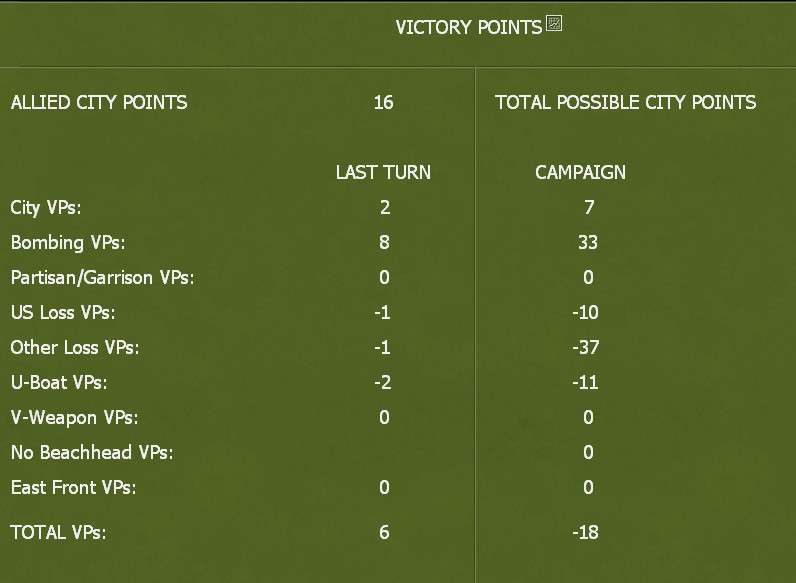
So 8 AAF goes for the less damaged portion of the Ruhr.
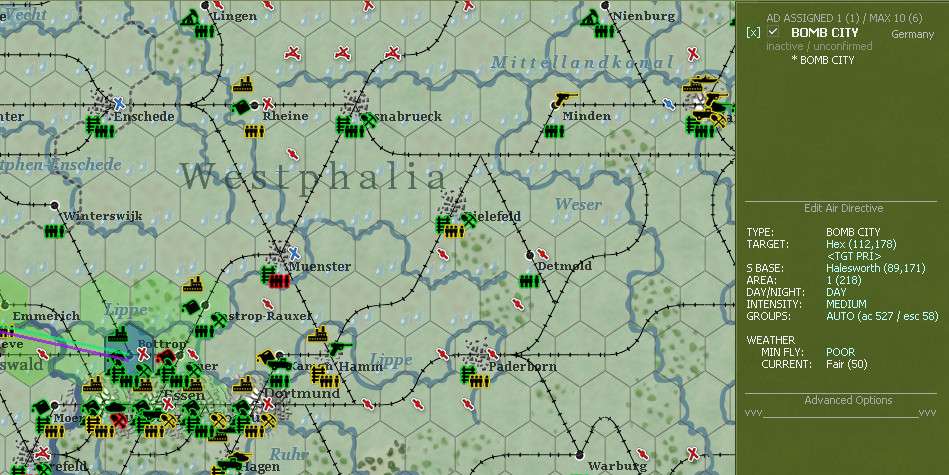
Fighter Command carries on inflicting a lot of losses and protecting some bomber raids at the same time.
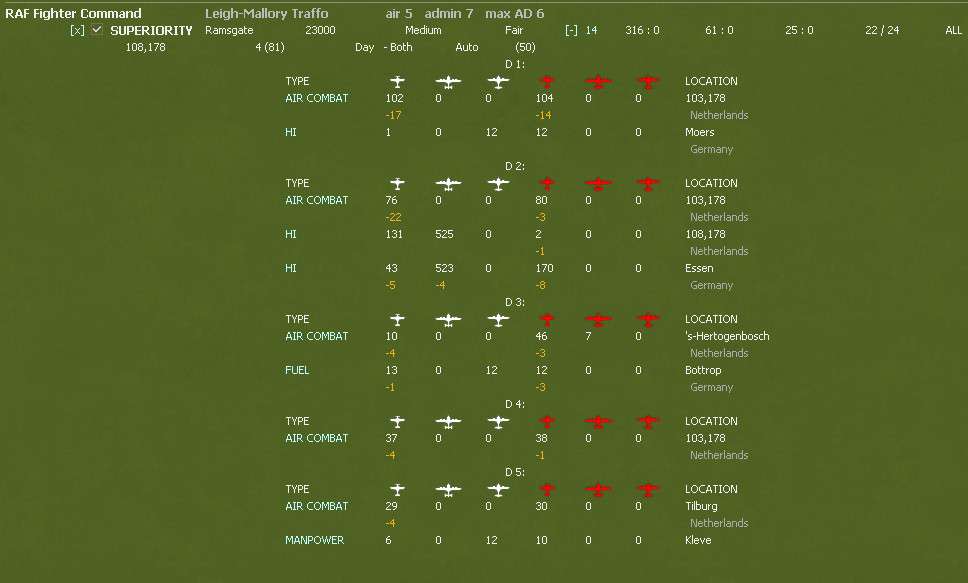
Bomber Command had another bad week
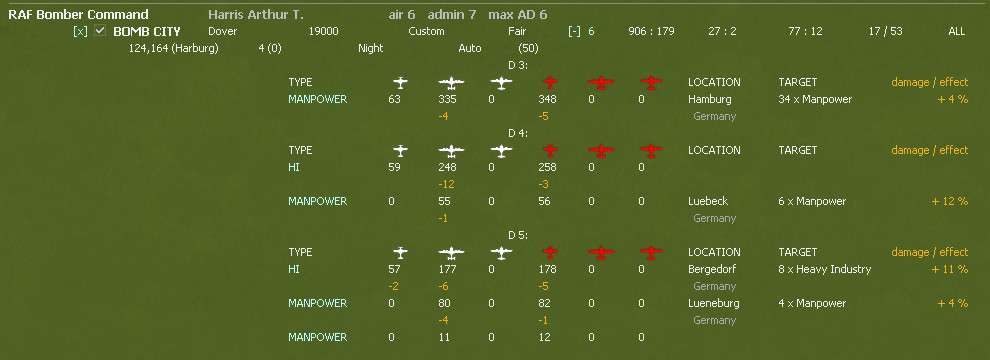
The lighter bombers from Tactical Air did a good job over Osnabruck

Star of the week was 8 AAF, substantial damage both to German industry and the defending Luftwaffe.

Sicily – finished off the cut off units. Moving up to assault Messina.
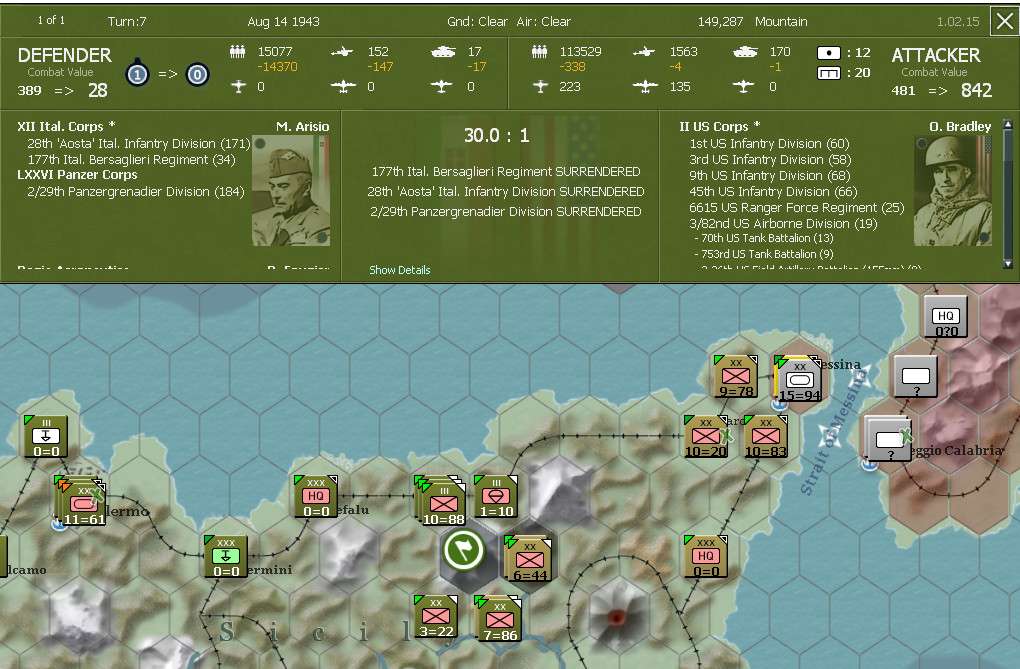
Italian bombing continues to focus on isolating the Axis units in the south. In addition to bombing the rail yards around Naples etc, they can't be receiving much supply through all that interdiction,
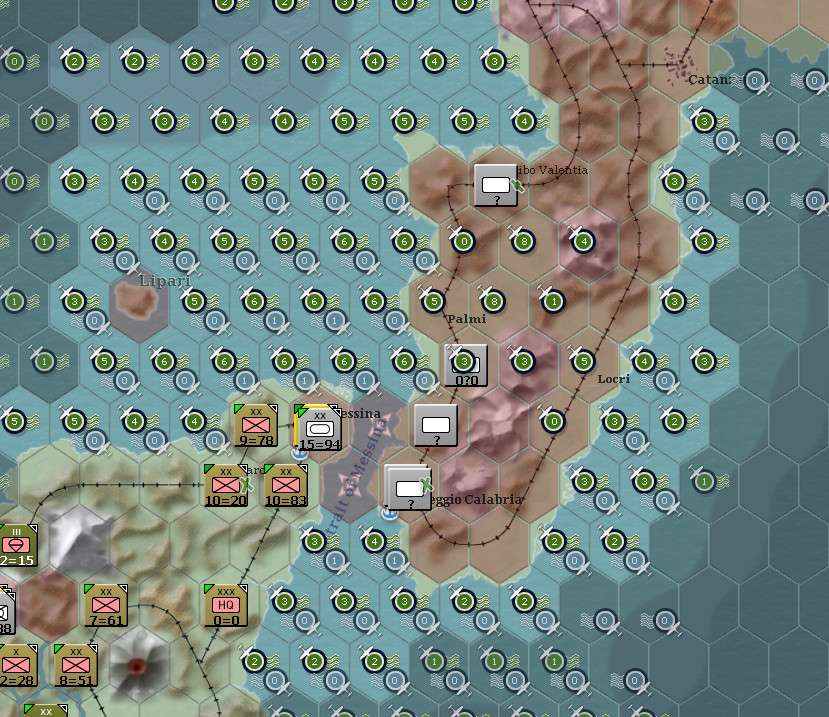
Usual morale settings. Also rested all the formations with fatigue >15.
Lost a lot of BC as a result (31 squadrons, 28 bombers) but 8 AAF not too affected (12 bomber squadrons resting).
Decided to swap BC and 8 AAF around. Used BC to hit the manpower and industrial sites around Hamburg while 8 AAF went for the northern Ruhr. Still using the 2E bombers from tactical air to hit smaller cities in this region.
VP score is ok, 8 per turn for bombing but want this up to 10, U-boats proving to be rather tricky to supress.

So 8 AAF goes for the less damaged portion of the Ruhr.

Fighter Command carries on inflicting a lot of losses and protecting some bomber raids at the same time.

Bomber Command had another bad week

The lighter bombers from Tactical Air did a good job over Osnabruck

Star of the week was 8 AAF, substantial damage both to German industry and the defending Luftwaffe.

Sicily – finished off the cut off units. Moving up to assault Messina.

Italian bombing continues to focus on isolating the Axis units in the south. In addition to bombing the rail yards around Naples etc, they can't be receiving much supply through all that interdiction,

RE: T7
Great AAR!
I haven't dared to try Grand Campaign yet in WitW, so this will help. [8D]
I haven't dared to try Grand Campaign yet in WitW, so this will help. [8D]
"To meaningless French Idealism, Liberty, Fraternity and Equality...we answer with German Realism, Infantry, Cavalry and Artillery" -Prince von Bülov, 1870-


- bomccarthy
- Posts: 414
- Joined: Fri Sep 06, 2013 7:32 pm
- Location: L.A.
RE: T6
ORIGINAL: loki100
The air war is good fun, very asymetric, very pleasing on the rare turns when you pull off a neat trick and inflict heavy losses, very frustrating when you drop into a trap laid for you [;)]
It's too bad that the game doesn't include aircraft loss points as negative VPs, with heavy bombers counting more than fighters. That would further incentivize the Allied player to minimize a/c losses and protect bomber raids with escorts. Currently, Allied players really don't fear losing huge numbers of US heavy bombers in 1943 because they know that plenty of replacements are arriving. Schweinfurt-level losses in the game won't trigger the type of command crisis that occurred in real life.
RE: T6
Brillant AAR Loki100! Thank you. [&o]
Could I ask a bit about your approach to Naval interdiction and squadrons you assign to it? I'm particularly interested in the Med, as not getting great results there even using the ideas from HarryBanana's guide
1) Do you move any naval squadrons from UK to the Med?
2) In your game currently how are you setup? ie What type of coastal squadrons are where? ie Do you have squadrons still covering N.African coast to allow inter-theatre troop movements? I had trouble both covering Italy, Sicily, Sardinia and having any cover in N.Africa for troops sailing back from Italy to UK in Winter in early '44 ready for D-Day. I found also my patrol craft pools were getting a bit on the low side, combined with bad winter weather I was struggling much more than when I played the game 18 months ago. Result was lost ships and elements from my divisions in transit.
3) What altitude do you use for Naval ADs? Do you use the 5K suggested by HarryBanana od the default 15k?
4) Do you use auto Naval patrols? I did but only for Coastal AF and Coastal Command
5) Do you use any LBs (not specifically naval trained) on this task (other than those assigned in the OOB at the start)?
Look forward to more from this thread
Could I ask a bit about your approach to Naval interdiction and squadrons you assign to it? I'm particularly interested in the Med, as not getting great results there even using the ideas from HarryBanana's guide
1) Do you move any naval squadrons from UK to the Med?
2) In your game currently how are you setup? ie What type of coastal squadrons are where? ie Do you have squadrons still covering N.African coast to allow inter-theatre troop movements? I had trouble both covering Italy, Sicily, Sardinia and having any cover in N.Africa for troops sailing back from Italy to UK in Winter in early '44 ready for D-Day. I found also my patrol craft pools were getting a bit on the low side, combined with bad winter weather I was struggling much more than when I played the game 18 months ago. Result was lost ships and elements from my divisions in transit.
3) What altitude do you use for Naval ADs? Do you use the 5K suggested by HarryBanana od the default 15k?
4) Do you use auto Naval patrols? I did but only for Coastal AF and Coastal Command
5) Do you use any LBs (not specifically naval trained) on this task (other than those assigned in the OOB at the start)?
Look forward to more from this thread
The user formerly known as jonboym
WITP:AE - Useful Info for Beginners
WitW Tutorials
WitW Beta/Alpha Tester
WITP:AE - Useful Info for Beginners
WitW Tutorials
WitW Beta/Alpha Tester
RE: T6
Just a question, why using 3 days in a row bombing (D3,D4,D5)? Why not D1,D3,D5?
"To meaningless French Idealism, Liberty, Fraternity and Equality...we answer with German Realism, Infantry, Cavalry and Artillery" -Prince von Bülov, 1870-


RE: T6
ORIGINAL: Sardaukar
Great AAR!
I haven't dared to try Grand Campaign yet in WitW, so this will help. [8D]
glad its useful, I don't think I'm using a particularly optimal approach but felt it was useful to link up results to what I am trying to achieve and why. That, to me, was the original mystery of the strategic airwar (ie why am I doing these things) so even if you end up doing some very different (and there are lots of alternative strategies), at least it provides a sort of rough framework.
Also, even more than WiTE, WiTW has long feedback loops between carrying out actions and seeing the consequences.
ORIGINAL: bomccarthy
ORIGINAL: loki100
The air war is good fun, very asymetric, very pleasing on the rare turns when you pull off a neat trick and inflict heavy losses, very frustrating when you drop into a trap laid for you [;)]
It's too bad that the game doesn't include aircraft loss points as negative VPs, with heavy bombers counting more than fighters. That would further incentivize the Allied player to minimize a/c losses and protect bomber raids with escorts. Currently, Allied players really don't fear losing huge numbers of US heavy bombers in 1943 because they know that plenty of replacements are arriving. Schweinfurt-level losses in the game won't trigger the type of command crisis that occurred in real life.
Aye, the way the VP system works, it rewards using the bomber force in an attritional mode. So yes, if you do a Schweinfurt style disaster you may have to rest a few weeks to rebuild morale but its not a massive issue. On the other hand, you do need to optimise air power as there are a lot of constraints to really pushing your ground forces.
Also more generally you manage your entire air strategy knowing that come mid-44 you will have total air superiority. A key point to the 'Point Blank' directive was that the Allies still feared the Luftwaffe and what it might do to the planned Normandy landings. You know you can steadily convert your FB-F squadrons to FB as there is no concern.
Not sure what can be done about this, all these games have a degree of hindsight influencing player choice.
ORIGINAL: Chuske
Brillant AAR Loki100! Thank you. [&o]
Could I ask a bit about your approach to Naval interdiction and squadrons you assign to it? I'm particularly interested in the Med, as not getting great results there even using the ideas from HarryBanana's guide
1) Do you move any naval squadrons from UK to the Med?
2) In your game currently how are you setup? ie What type of coastal squadrons are where? ie Do you have squadrons still covering N.African coast to allow inter-theatre troop movements? I had trouble both covering Italy, Sicily, Sardinia and having any cover in N.Africa for troops sailing back from Italy to UK in Winter in early '44 ready for D-Day. I found also my patrol craft pools were getting a bit on the low side, combined with bad winter weather I was struggling much more than when I played the game 18 months ago. Result was lost ships and elements from my divisions in transit.
3) What altitude do you use for Naval ADs? Do you use the 5K suggested by HarryBanana od the default 15k?
4) Do you use auto Naval patrols? I did but only for Coastal AF and Coastal Command
5) Do you use any LBs (not specifically naval trained) on this task (other than those assigned in the OOB at the start)?
Look forward to more from this thread
I'm not sure if the changes were planned but my feeling is that naval air is more effective in this build than earlier. So I've not moved any naval air to the Med (which I think is a bit gamey to be honest) and left the N African units spread out as they start. In past games I've lost too much shipping to attrition etc and have come to appreciate the need for maintaining low level auto-patrols all along the coast.
I'm letting it default to 15,000', looking at the #5-6 interdiction north of Messina that is working out fine. I've turned off auto naval for everything but the coastal commands, think you can end up with a lot of unexpected losses otherwise.
I protected the British landings at Sicily with Wellingtons using the naval load out and will probably do the same when I invade Sardinia. You don't get as good a result as with the specialist planes but its usually enough to cancel out any local axis interdiction values.
ORIGINAL: Sardaukar
Just a question, why using 3 days in a row bombing (D3,D4,D5)? Why not D1,D3,D5?
You want to recon before and after, so I would never do strat bombing on D1 due to this. Against the AI its fine to stick to a pattern, its not that subtle in its response and it certainly doesn't track your chosen days/altitude etc in planning its response. In a PBEM I'll mix both of these around in case my opponent is trying to be efficient in their own allocations.
The axis player can set up their day fighters either in designated AS boxes or leave them to auto-intercept. There are good and bad to both, but if they do AS, they may want not to fly when you don't (less operational losses). Shifting your days means they have no choice but to fly all week - assuming they also want to disrupt your recon efforts. Equally every now and then bombing at high altitude can bypass the axis fighters completely (at a cost in accuracy of course)
T8
T8
Usual settings for morale and fatigue. Resting 19 Bomber Command squadrons (16 bombers) and only 4 from 8 AAF. Do think that keeping the days/week and overall intensity down is allowing me a much more steady bombing campaign than really pushing it and sometimes having few, if any, available formations. Also the 55 for morale is a bit lower than I've used in the past but seems to work out fine.
The cost is in terms of slightly lower VP. What I might do as we approach the autumn is increase the intensity on the grounds that I will have periods of heavy rain and thus enforced rest.
The U-boat score is annoying.
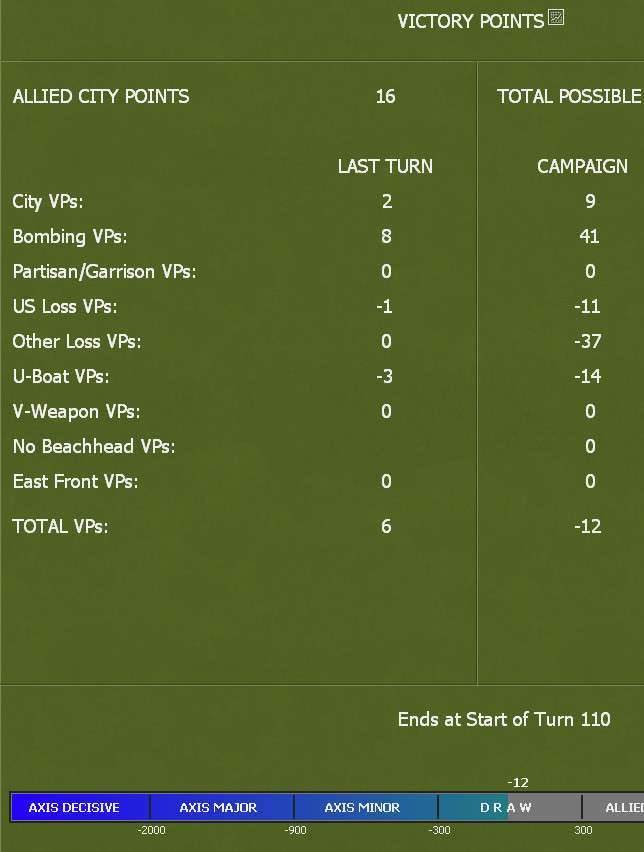
8 AAF goes for a cluster of medium sized targets east of the Rhine.
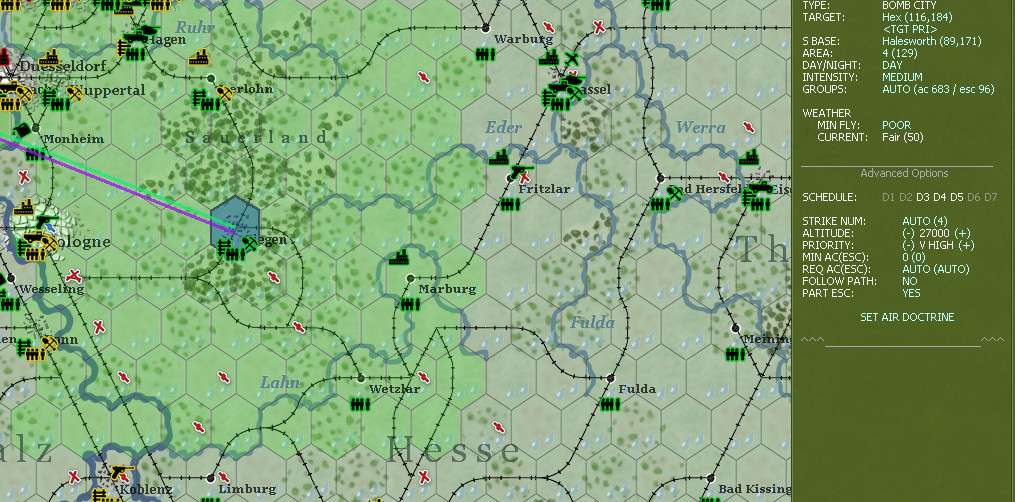
BC for Hannover (HI and manpower as usual).
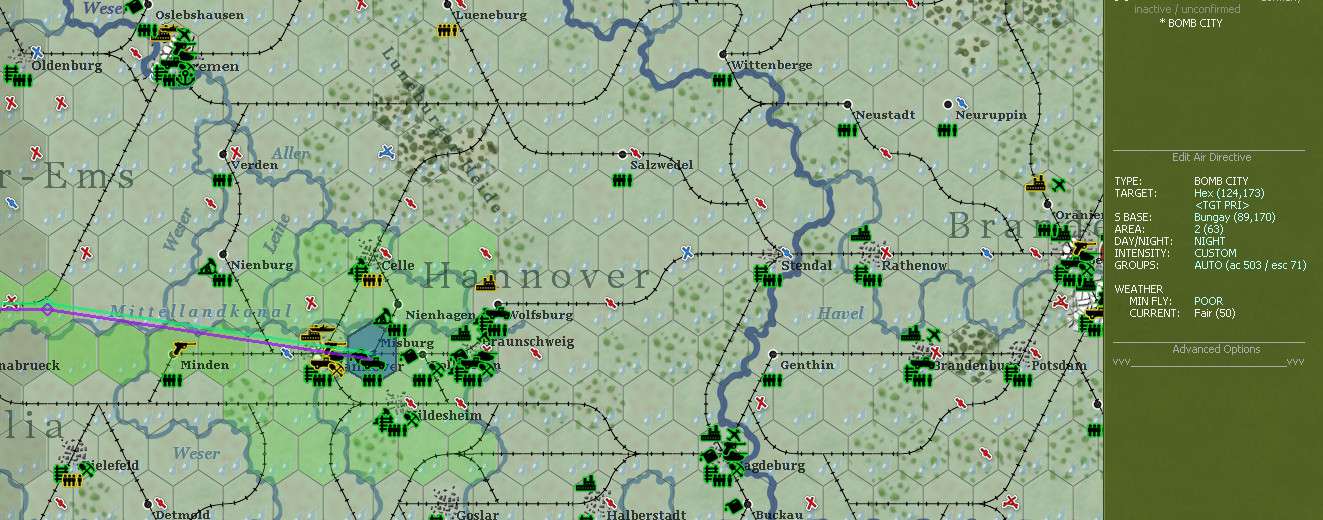
Fighter Command does its usual intervention over the Rhineland and again this is proving very worthwhile.
As a plane management issue, the Spitfire V you start with have a decent range and are ok with other stats but you have virtually no spares (especially for the Vb). So now upgrading to the VIII and IX, the VII has better range. Some I'm converting to FB and sending off to train on Typhoons.

Bomber Command has its usual indifferent performance outside the radar range. Think I might as well stick to the Ruhr and Rhineland for the moment.

A smaller raid at Detmold was more succesful. Useful to sometimes pick off these relatively large isolated urban areas.

Still doing fringe raids with Tactical Air, that is a useful addition to the overall bombing effort.

Main 8 AAF effort is ok, nothing really devastating.
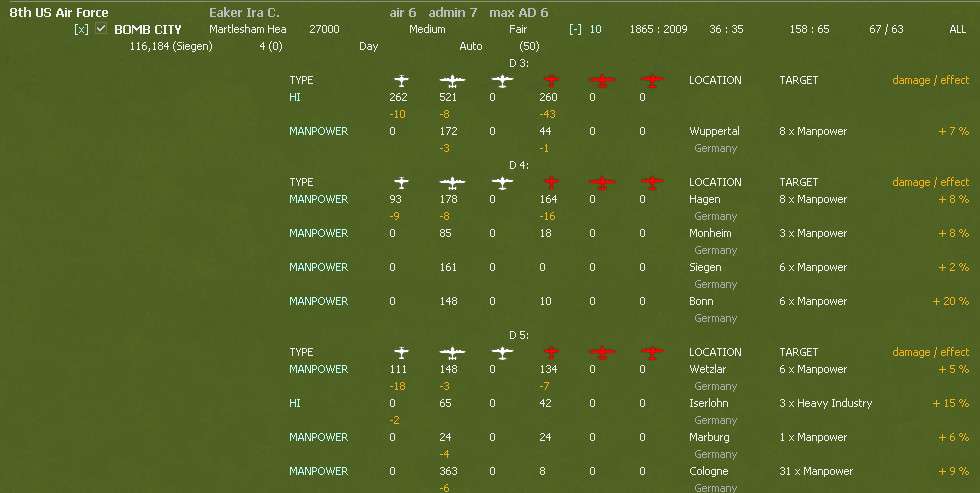
But I did finally hit the Luebeck U-Boats with a one day focussed raid.

Overall air losses. Trading pilots at 3:2 and planes at 1:1. Planes are less important but the \axis lacks the trained pilots to sustain this.
Bit surprised my outright flak losses are low ... but a lot of flak damaged planes become operational losses.

Not much going on in Sicily – I'll look at that in detail in the next post as its time to attack Messina.
Usual settings for morale and fatigue. Resting 19 Bomber Command squadrons (16 bombers) and only 4 from 8 AAF. Do think that keeping the days/week and overall intensity down is allowing me a much more steady bombing campaign than really pushing it and sometimes having few, if any, available formations. Also the 55 for morale is a bit lower than I've used in the past but seems to work out fine.
The cost is in terms of slightly lower VP. What I might do as we approach the autumn is increase the intensity on the grounds that I will have periods of heavy rain and thus enforced rest.
The U-boat score is annoying.

8 AAF goes for a cluster of medium sized targets east of the Rhine.

BC for Hannover (HI and manpower as usual).

Fighter Command does its usual intervention over the Rhineland and again this is proving very worthwhile.
As a plane management issue, the Spitfire V you start with have a decent range and are ok with other stats but you have virtually no spares (especially for the Vb). So now upgrading to the VIII and IX, the VII has better range. Some I'm converting to FB and sending off to train on Typhoons.

Bomber Command has its usual indifferent performance outside the radar range. Think I might as well stick to the Ruhr and Rhineland for the moment.

A smaller raid at Detmold was more succesful. Useful to sometimes pick off these relatively large isolated urban areas.

Still doing fringe raids with Tactical Air, that is a useful addition to the overall bombing effort.

Main 8 AAF effort is ok, nothing really devastating.

But I did finally hit the Luebeck U-Boats with a one day focussed raid.

Overall air losses. Trading pilots at 3:2 and planes at 1:1. Planes are less important but the \axis lacks the trained pilots to sustain this.
Bit surprised my outright flak losses are low ... but a lot of flak damaged planes become operational losses.

Not much going on in Sicily – I'll look at that in detail in the next post as its time to attack Messina.
- bomccarthy
- Posts: 414
- Joined: Fri Sep 06, 2013 7:32 pm
- Location: L.A.
RE: T6
ORIGINAL: loki100
ORIGINAL: Chuske
Brillant AAR Loki100! Thank you. [&o]
Could I ask a bit about your approach to Naval interdiction and squadrons you assign to it? I'm particularly interested in the Med, as not getting great results there even using the ideas from HarryBanana's guide
1) Do you move any naval squadrons from UK to the Med?
2) In your game currently how are you setup? ie What type of coastal squadrons are where? ie Do you have squadrons still covering N.African coast to allow inter-theatre troop movements? I had trouble both covering Italy, Sicily, Sardinia and having any cover in N.Africa for troops sailing back from Italy to UK in Winter in early '44 ready for D-Day. I found also my patrol craft pools were getting a bit on the low side, combined with bad winter weather I was struggling much more than when I played the game 18 months ago. Result was lost ships and elements from my divisions in transit.
3) What altitude do you use for Naval ADs? Do you use the 5K suggested by HarryBanana od the default 15k?
4) Do you use auto Naval patrols? I did but only for Coastal AF and Coastal Command
5) Do you use any LBs (not specifically naval trained) on this task (other than those assigned in the OOB at the start)?
Look forward to more from this thread
I'm not sure if the changes were planned but my feeling is that naval air is more effective in this build than earlier. So I've not moved any naval air to the Med (which I think is a bit gamey to be honest) and left the N African units spread out as they start. In past games I've lost too much shipping to attrition etc and have come to appreciate the need for maintaining low level auto-patrols all along the coast.
I'm letting it default to 15,000', looking at the #5-6 interdiction north of Messina that is working out fine. I've turned off auto naval for everything but the coastal commands, think you can end up with a lot of unexpected losses otherwise.
I protected the British landings at Sicily with Wellingtons using the naval load out and will probably do the same when I invade Sardinia. You don't get as good a result as with the specialist planes but its usually enough to cancel out any local axis interdiction values.
Naval patrols do seem more effective on auto than they used to be. In my previous games, I would regularly lose ships and their cargo immediately upon leaving Oran in early 1945, even though the closest Axis base was in Albania. I couldn't figure out what was attacking them, a Nazi-sympathizing Kraken?
In my current game, I am only setting up Naval patrol directives to protect invasion sites. In Spring '44 good weather turns with no naval patrol directives, I usually control most of the Med ocean hexes to within 40 miles of the French coast, as well all around the Italian coastline that I control on land. I just make sure to spread the Coastal AF patrol planes and bombers along the coastlines I control.
- bomccarthy
- Posts: 414
- Joined: Fri Sep 06, 2013 7:32 pm
- Location: L.A.
RE: T8
ORIGINAL: loki100
As a plane management issue, the Spitfire V you start with have a decent range and are ok with other stats but you have virtually no spares (especially for the Vb). So now upgrading to the VIII and IX, the VII has better range. Some I'm converting to FB and sending off to train on Typhoons.
This is important for new players to keep track of - historically, the Spitfire V ceased production by the end of 1942. Because more Spitfire Vs were produced than any other model, the RAF continued using them in combat roles through 1945. However, you need to carefully keep track of units equipped with them. In 1943 even the original Spitfire IX was being replaced on the production line by the specialized versions - the low altitude LF IX and the high altitude HF IX. Because its critical altitude is only 18,000 ft, I send the LF IX to the Med and 2nd TAF, while trying to keep the IX, HF IX, and VIII in Fighter Command for use in AS directives over the Ruhr (with the altitude set at 28,000 ft).
Something else to watch in the RAF are the Dutch and Norwegian squadrons - they have very few pilot replacements, so you may have to disband one or two squadrons as time goes on.
Finally, I am constantly juggling the composition of naval patrol and torpedo bomber units because they have very thin plane pools and low production rates. There are also a plethora of types - don't overlook the Venturas and Catalinas, which have great range.
RE: T8
Can i ask why you fly BC at 19,000ft and 8th AF at 24,000ft? Apart from the low flak band ending at 21,000ft, and some planes (Wellingtons for instance) having limited ceilings, i'm struggling to come up with a logical plan for bombing altitude. High level recon is aimed at 35,000ft but i cant see any AAR's with anyone flying that high.
"Gauls! We have nothing to fear; except perhaps that the sky may fall on our heads tomorrow. But as we all know, tomorrow never comes!!" - Chief Vitalstatistix
- bomccarthy
- Posts: 414
- Joined: Fri Sep 06, 2013 7:32 pm
- Location: L.A.
RE: T8
ORIGINAL: coolts
Can i ask why you fly BC at 19,000ft and 8th AF at 24,000ft? Apart from the low flak band ending at 21,000ft, and some planes (Wellingtons for instance) having limited ceilings, i'm struggling to come up with a logical plan for bombing altitude. High level recon is aimed at 35,000ft but i cant see any AAR's with anyone flying that high.
Speaking for myself, I tend to follow historical mission parameters as they evolved by early 1945. Altitude is a balancing act between flak vulnerability and bombing accuracy. In general, accuracy increases as altitude decreases but so does vulnerability to flak. In the documentary Fog of War, Robert McNamara recalled performing analysis (as one of Wedermeyer's "Whiz Kids") that demonstrated lowering the bombing altitude from 25,000+ ft to 20,000 ft or less had a direct impact on the level of damage inflicted on a strategic target, such that fewer return sorties were required to put the target out of action. They concluded that the increased casualties on the first mission at 20,000 ft were more than offset by the casualties not suffered in subsequent missions to the target.
From an airplane standpoint, USAAF heavy bombers were optimized for flight between 25,000 ft and 32,000 ft. Their turbosuperchargers maintained their max engine horsepower from sea level to 28,000 ft, where the thinner air gave them their fastest airspeed. RAF heavy bombers, on the other hand, only had single-stage superchargers mechanically driven off the crankshaft, which meant that their engine horsepower began dropping rapidly above 18,000 ft. On the other hand, flak was usually a little less accurate at night, so the lower altitude did not mean significantly higher flak casualties.
In the Pacific, the 21st Bomber Command essentially doubled down on RAF Bomber Command's tactics - their B-29s bombed from 8,000 to 12,000 feet at night. Note also that the 8th AF flew their carpet bombing missions against German ground units (such as COBRA in Normandy) from an altitude of 8,000 ft to 11,000 ft.
USAAF medium bombers (B-25, B-26, A-26) didn't have turbosuperchargers, so they generally flew missions at 18,000 feet or less.
RE: T8
ORIGINAL: bomccarthy
ORIGINAL: loki100
As a plane management issue, the Spitfire V you start with have a decent range and are ok with other stats but you have virtually no spares (especially for the Vb). So now upgrading to the VIII and IX, the VII has better range. Some I'm converting to FB and sending off to train on Typhoons.
This is important for new players to keep track of - historically, the Spitfire V ceased production by the end of 1942. Because more Spitfire Vs were produced than any other model, the RAF continued using them in combat roles through 1945. However, you need to carefully keep track of units equipped with them. In 1943 even the original Spitfire IX was being replaced on the production line by the specialized versions - the low altitude LF IX and the high altitude HF IX. Because its critical altitude is only 18,000 ft, I send the LF IX to the Med and 2nd TAF, while trying to keep the IX, HF IX, and VIII in Fighter Command for use in AS directives over the Ruhr (with the altitude set at 28,000 ft).
Something else to watch in the RAF are the Dutch and Norwegian squadrons - they have very few pilot replacements, so you may have to disband one or two squadrons as time goes on.
Finally, I am constantly juggling the composition of naval patrol and torpedo bomber units because they have very thin plane pools and low production rates. There are also a plethora of types - don't overlook the Venturas and Catalinas, which have great range.
agree, especially about constantly having to fuss over the usage of the naval planes. Quick warning, as with the recon planes, some are actually produced in larger numbers than the production chart shows. Look in the turn log and you'll see reports of the AI refitting some of the generic type to more specialist usages when needed.
With the RAF, I tend to only convert the British and Canadian FB-F formations to FB. Inevitably as ground attack aircraft they take heavier losses and you can run out of the smaller national pools if you are not careful.
ORIGINAL: coolts
Can i ask why you fly BC at 19,000ft and 8th AF at 24,000ft? Apart from the low flak band ending at 21,000ft, and some planes (Wellingtons for instance) having limited ceilings, i'm struggling to come up with a logical plan for bombing altitude. High level recon is aimed at 35,000ft but i cant see any AAR's with anyone flying that high.
ORIGINAL: bomccarthy
ORIGINAL: coolts
Can i ask why you fly BC at 19,000ft and 8th AF at 24,000ft? Apart from the low flak band ending at 21,000ft, and some planes (Wellingtons for instance) having limited ceilings, i'm struggling to come up with a logical plan for bombing altitude. High level recon is aimed at 35,000ft but i cant see any AAR's with anyone flying that high.
Speaking for myself, I tend to follow historical mission parameters as they evolved by early 1945. Altitude is a balancing act between flak vulnerability and bombing accuracy. In general, accuracy increases as altitude decreases but so does vulnerability to flak. In the documentary Fog of War, Robert McNamara recalled performing analysis (as one of Wedermeyer's "Whiz Kids") that demonstrated lowering the bombing altitude from 25,000+ ft to 20,000 ft or less had a direct impact on the level of damage inflicted on a strategic target, such that fewer return sorties were required to put the target out of action. They concluded that the increased casualties on the first mission at 20,000 ft were more than offset by the casualties not suffered in subsequent missions to the target.
From an airplane standpoint, USAAF heavy bombers were optimized for flight between 25,000 ft and 32,000 ft. Their turbosuperchargers maintained their max engine horsepower from sea level to 28,000 ft, where the thinner air gave them their fastest airspeed. RAF heavy bombers, on the other hand, only had single-stage superchargers mechanically driven off the crankshaft, which meant that their engine horsepower began dropping rapidly above 18,000 ft. On the other hand, flak was usually a little less accurate at night, so the lower altitude did not mean significantly higher flak casualties.
In the Pacific, the 21st Bomber Command essentially doubled down on RAF Bomber Command's tactics - their B-29s bombed from 8,000 to 12,000 feet at night. Note also that the 8th AF flew their carpet bombing missions against German ground units (such as COBRA in Normandy) from an altitude of 8,000 ft to 11,000 ft.
USAAF medium bombers (B-25, B-26, A-26) didn't have turbosuperchargers, so they generally flew missions at 18,000 feet or less.
As in the main response there are a lot of trade offs. In effect the strategic airwar is an exercise in linear programming with lots of constraints and trade offs. Its no accident that a lot of the post-war evolution of statistics and operations research came from the analysis carried out to support the air war.
In addition to the safety/accuracy trade off there are others, some less clearly documented. Going high causes extra fatigue (basically you are freezing your crews to death) so the relative safety above flak/fighters is traded off against more accidents (and of course less effective results).
I do some high altitude raids. The British mosquito bombers, set to daylight, are good if you want to go beyond Berlin - they can fly high enough to escape much damage but equally its not going to be a devastating raid.
T9
T9
Usual morale and fatigue settings. This rested 9 Strategic bomber squadrons (7 from 8 AAF) but I lost most of the US fighter escorts. Decided to make the least fatigued operate in any case as I do need some protection.
VP situation not really moving (good or bad). Would like to drive the U-boat score down though.
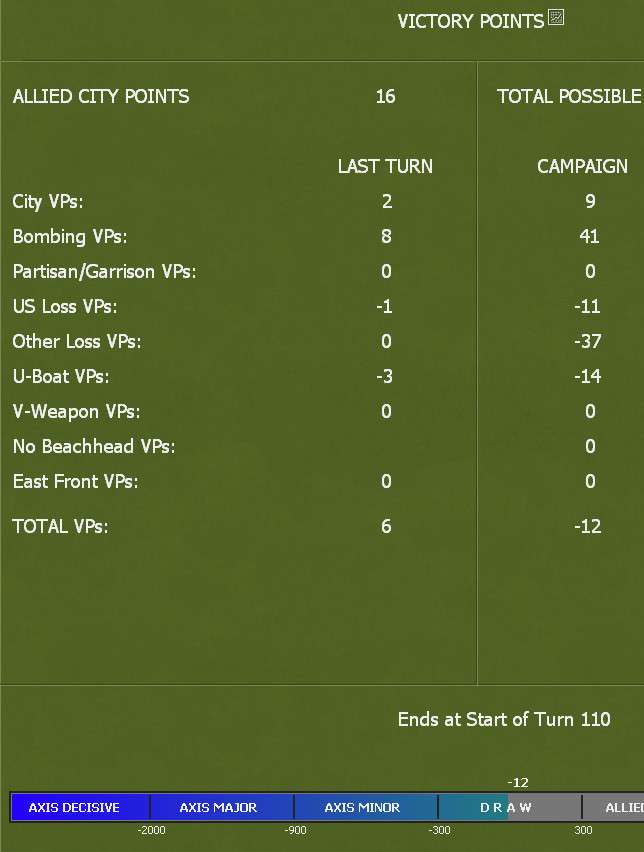
Bomber Command. Decided to keep it simple, its more dangerous within the UK radar range and there are still a lot of targets in the Ruhr.
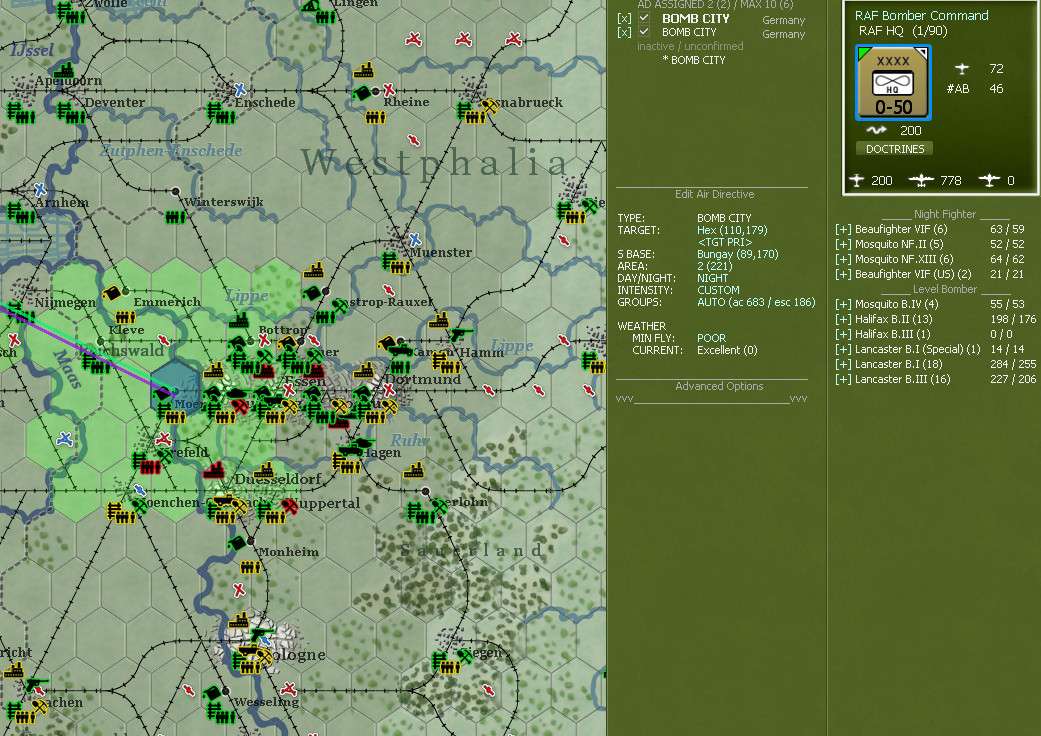
Main US attack is on the Hannover region (not least there is a U-boat factory here). Also did another D7 raid on a single U-boat producing city.
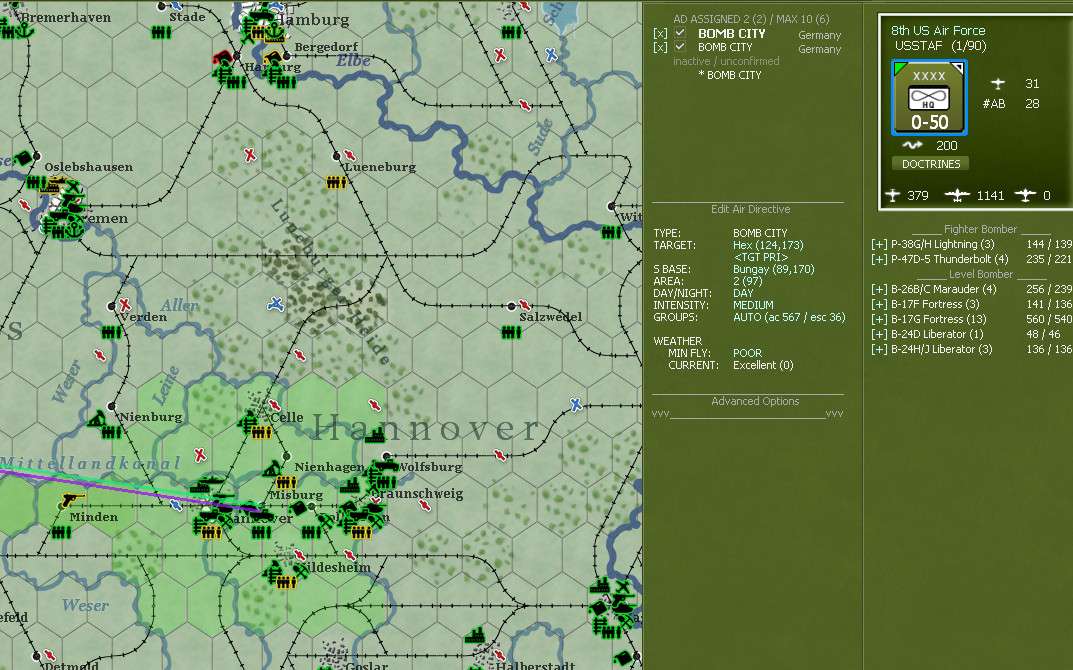
Set up for the only active Naval Patrol. Note I don't have that many active planes (many are resting as the auto-missions take their toll). Still doing a ground interdiction mission to the north of Reggio Calabria. Most of the FB-F formations are in the FB mode (but with a malus as I have not released them to retrain as bombers).
Shifted the strategic bombers to the east coast of Italy around Brindisi to knock down the ports and rail yards in that region.
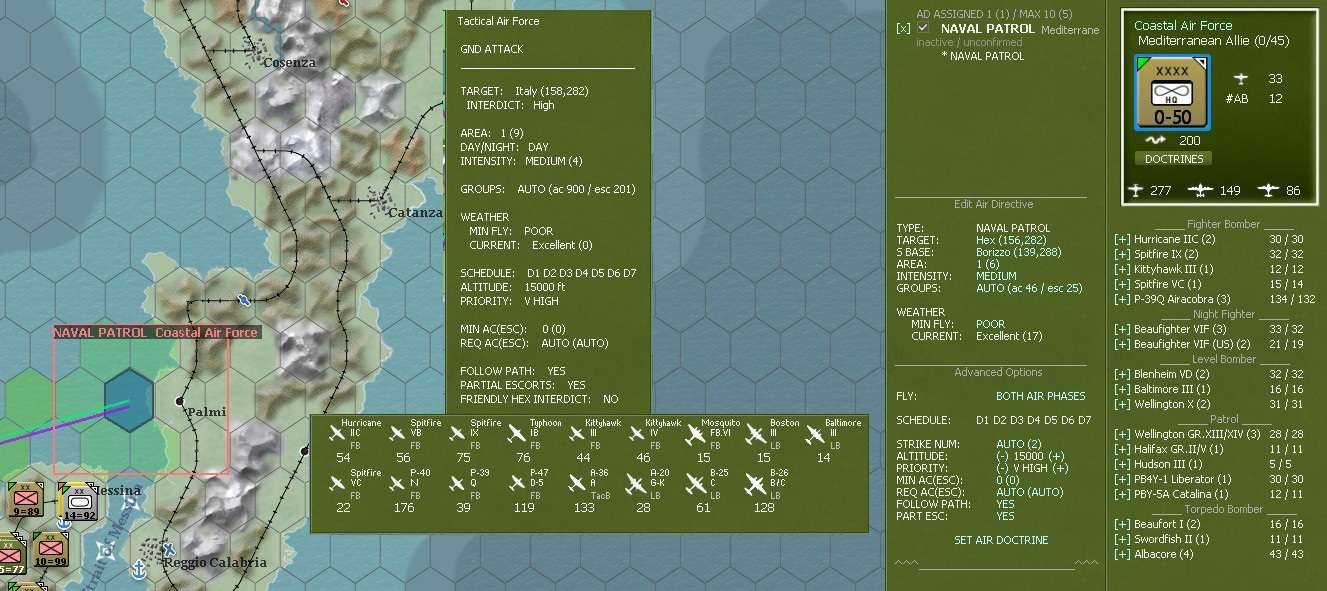
Fighter Command continues to deliver good results. Despite its heavy losses am able to keep up a reasonable intensity of commitment.

Bomber Command does seem to do a much better job when the bombers know where they are ...
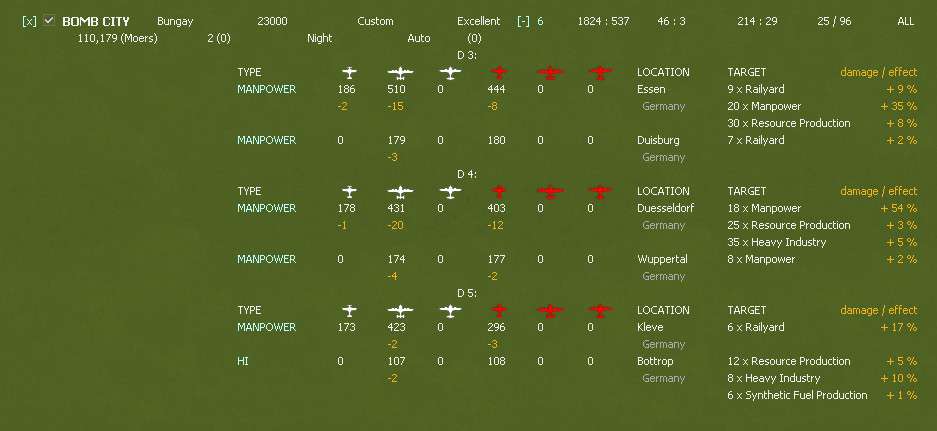
2 Tactical Air carries on hitting individual cities within the Fighter Command protection zone. Thats a useful addition both to the VP score and to reducing German rail capacity. I'll need to stop this soon and go back to hitting the French rail net though.
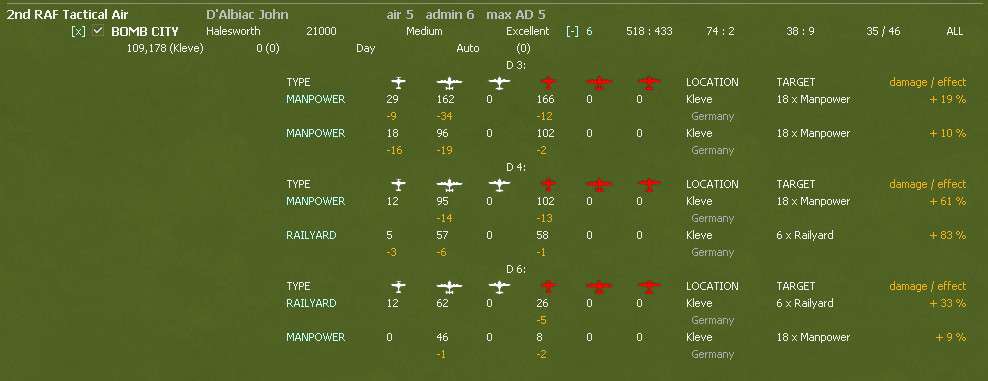
8 AAF's U-boat raid, should reduce the VP loss a bit.

And the main raid. Reasonable amount of damage.
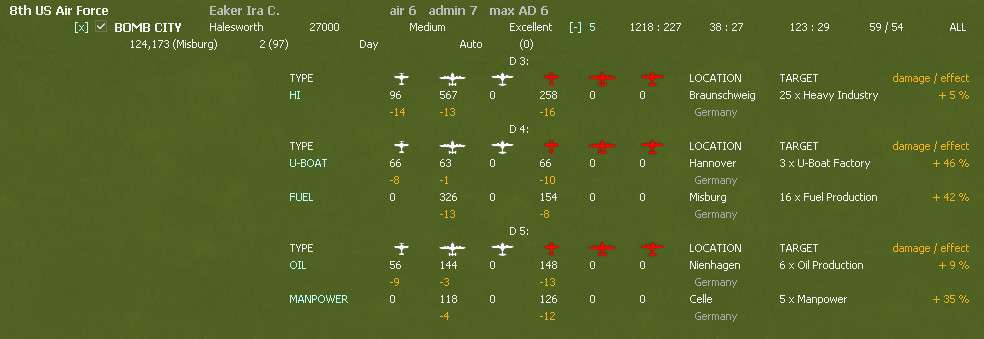
Italy – interdiction. Note that even only with a few planes, the naval interdiction score is high enough to give me naval control of the region, Land interdiction down a bit but still good enough to be costing the Germans trucks etc and to make any movement of combat units quite costly.
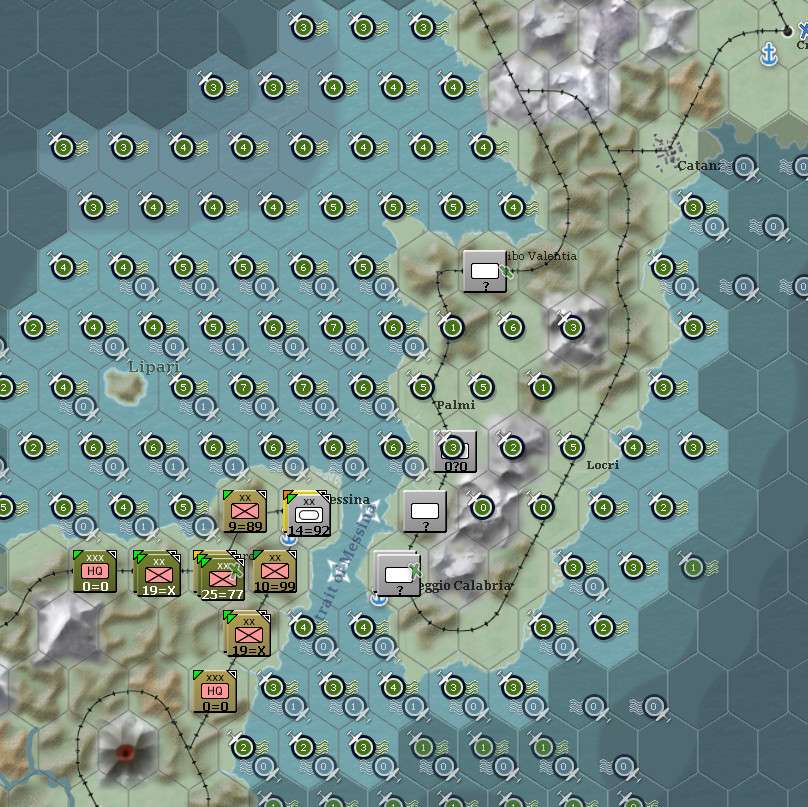
Time for some ground action. Set up for the opening attack on Messina. Note the 4 Naval TF offshore.
If you are not used to this its a bit counter-intuitive but you can move TF around during your turn and as long as they go back to their port at the end of the turn they will gain prep pts for the next invasion (just make sure you send the right TF back to the right port).
Tactically, the heavy naval guns cause a lot of disruptions when you attack. In France, using all 6 of those various German held ports can usually reduce them in 1-2 turns.
The odds are not good, but I have 3 US infantry divisions in reserve mode (hopefully one will joing in) and the naval gunfire will reduce the axis cv before any actual fighting.
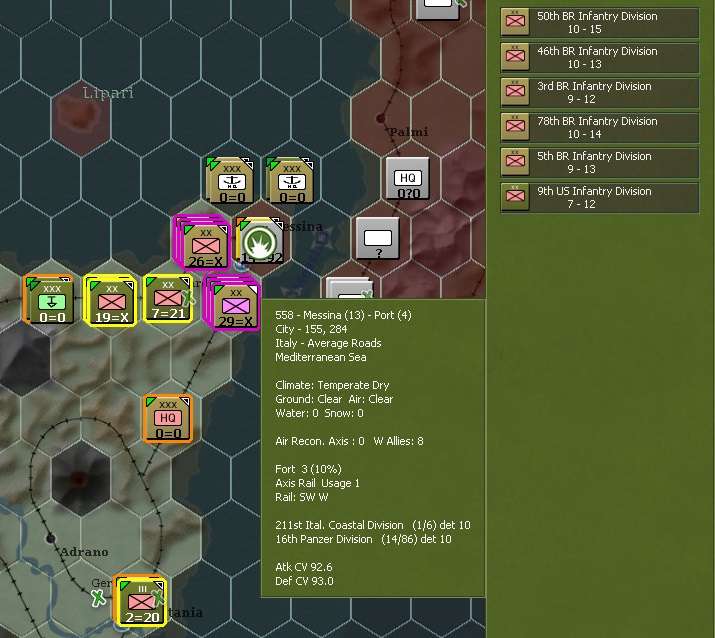
First attack failed. Thats a lot of artillery the AI has deployed and my attack stopped at some distance. Good thing is the loss of a fort level.
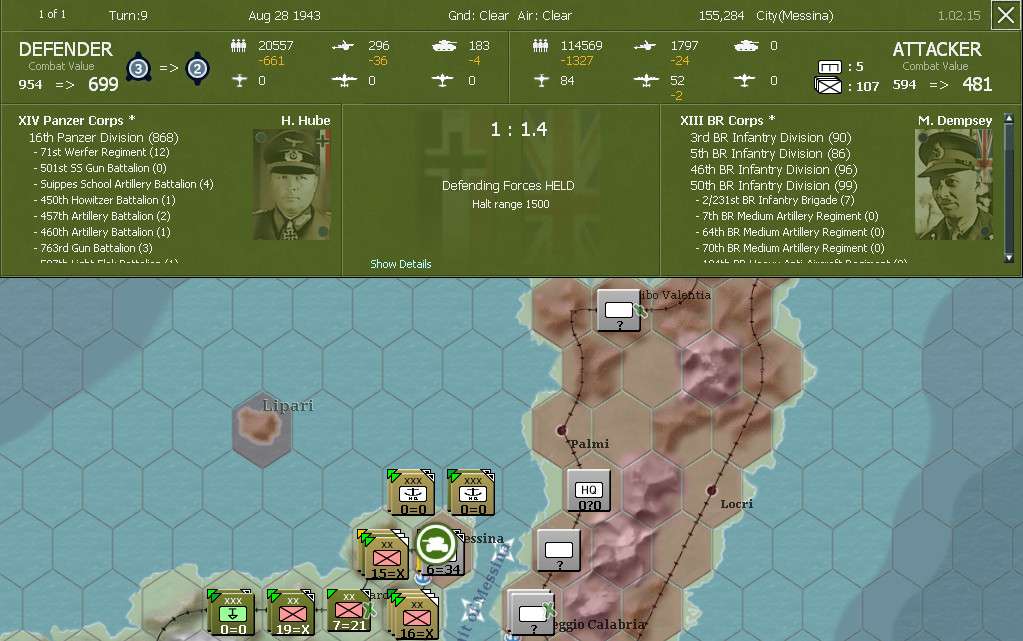
Deciding whether to attack again is a bit of an art not science. Here I decided to do so as I had three fresh US infantry formations so I rotated my combat units and risked a second attack.
Failed again but the German defences are wrecked, they must have a lot of disrupted elements and hopefully their supply problems might make it hard for them to recover.

If you lack a fresh reserve, I'd tend not to double-attack. Fatigue builds up quickly can have a real impact on your attacking units, so all you do is take losses for no likely gains.
One of the many times when you wish for an army made up of Soviet Guards Rifle Corps backed by artillery and rocket divisions. In WiTE2 you can get this sort of stack up to over 200 cv (if its well rested) and the ability to rotate in fresh units. Sigh ....
Usual morale and fatigue settings. This rested 9 Strategic bomber squadrons (7 from 8 AAF) but I lost most of the US fighter escorts. Decided to make the least fatigued operate in any case as I do need some protection.
VP situation not really moving (good or bad). Would like to drive the U-boat score down though.

Bomber Command. Decided to keep it simple, its more dangerous within the UK radar range and there are still a lot of targets in the Ruhr.

Main US attack is on the Hannover region (not least there is a U-boat factory here). Also did another D7 raid on a single U-boat producing city.

Set up for the only active Naval Patrol. Note I don't have that many active planes (many are resting as the auto-missions take their toll). Still doing a ground interdiction mission to the north of Reggio Calabria. Most of the FB-F formations are in the FB mode (but with a malus as I have not released them to retrain as bombers).
Shifted the strategic bombers to the east coast of Italy around Brindisi to knock down the ports and rail yards in that region.

Fighter Command continues to deliver good results. Despite its heavy losses am able to keep up a reasonable intensity of commitment.

Bomber Command does seem to do a much better job when the bombers know where they are ...

2 Tactical Air carries on hitting individual cities within the Fighter Command protection zone. Thats a useful addition both to the VP score and to reducing German rail capacity. I'll need to stop this soon and go back to hitting the French rail net though.

8 AAF's U-boat raid, should reduce the VP loss a bit.

And the main raid. Reasonable amount of damage.

Italy – interdiction. Note that even only with a few planes, the naval interdiction score is high enough to give me naval control of the region, Land interdiction down a bit but still good enough to be costing the Germans trucks etc and to make any movement of combat units quite costly.

Time for some ground action. Set up for the opening attack on Messina. Note the 4 Naval TF offshore.
If you are not used to this its a bit counter-intuitive but you can move TF around during your turn and as long as they go back to their port at the end of the turn they will gain prep pts for the next invasion (just make sure you send the right TF back to the right port).
Tactically, the heavy naval guns cause a lot of disruptions when you attack. In France, using all 6 of those various German held ports can usually reduce them in 1-2 turns.
The odds are not good, but I have 3 US infantry divisions in reserve mode (hopefully one will joing in) and the naval gunfire will reduce the axis cv before any actual fighting.

First attack failed. Thats a lot of artillery the AI has deployed and my attack stopped at some distance. Good thing is the loss of a fort level.

Deciding whether to attack again is a bit of an art not science. Here I decided to do so as I had three fresh US infantry formations so I rotated my combat units and risked a second attack.
Failed again but the German defences are wrecked, they must have a lot of disrupted elements and hopefully their supply problems might make it hard for them to recover.

If you lack a fresh reserve, I'd tend not to double-attack. Fatigue builds up quickly can have a real impact on your attacking units, so all you do is take losses for no likely gains.
One of the many times when you wish for an army made up of Soviet Guards Rifle Corps backed by artillery and rocket divisions. In WiTE2 you can get this sort of stack up to over 200 cv (if its well rested) and the ability to rotate in fresh units. Sigh ....
RE: T9
What version of the game are you using, the beta?
Messina is hard to take but in my last game once I had it the AI goofed and left one of the hex next to the ferry just above Reggio Caabria unoccupied, once I moved acroos the ferry I also noticed from my recon flights the AI moved a lot of troops from protecting coasts (Salerno and Taranto areas) to the toe of Italy, made my planned landing near Taranto much easier. Only thing I found landing in the heel was it took ages to slog up to Cassino, took me till '44 to get up there, be interesting to see how much quicker you do.
Messina is hard to take but in my last game once I had it the AI goofed and left one of the hex next to the ferry just above Reggio Caabria unoccupied, once I moved acroos the ferry I also noticed from my recon flights the AI moved a lot of troops from protecting coasts (Salerno and Taranto areas) to the toe of Italy, made my planned landing near Taranto much easier. Only thing I found landing in the heel was it took ages to slog up to Cassino, took me till '44 to get up there, be interesting to see how much quicker you do.
The user formerly known as jonboym
WITP:AE - Useful Info for Beginners
WitW Tutorials
WitW Beta/Alpha Tester
WITP:AE - Useful Info for Beginners
WitW Tutorials
WitW Beta/Alpha Tester
RE: T9
Yes its the most recent beta.
Think you need to keep on running invasions to make progress in Italy. My last PBEM my opponent really disrupted my planned retreat by both really committing to an overland advance up the Adriatic and backing this with a lot of one division sized landings - safer in that region as its hard for the axis to really concentrate.
You still need a large well supported landing around Rome sometime late 43/early 44
What I always find hard in Italy is the need to keep on re-arranging your forces as they shift from the front line (say the units that start invading Sicily) to dropping into reserve (I tend to use the Sicily units for the Rome landings).
Think you need to keep on running invasions to make progress in Italy. My last PBEM my opponent really disrupted my planned retreat by both really committing to an overland advance up the Adriatic and backing this with a lot of one division sized landings - safer in that region as its hard for the axis to really concentrate.
You still need a large well supported landing around Rome sometime late 43/early 44
What I always find hard in Italy is the need to keep on re-arranging your forces as they shift from the front line (say the units that start invading Sicily) to dropping into reserve (I tend to use the Sicily units for the Rome landings).
T10
T10
One thing that does seem to be working in this game is the combination of only using the strategic bombers 2-3 days a week and the 55 morale threshold. In the past I've tried for 4-5 days and used 65 and had periods where very little effort can be sustained and have had to accept lulls while the bombers recover.
This turn only had to rest 11 BC formations and 5 from 8 AAF.
VP situation. Bombing points slowly increasing and U-Boats back down to 2. More ground losses due to the Messina battles.
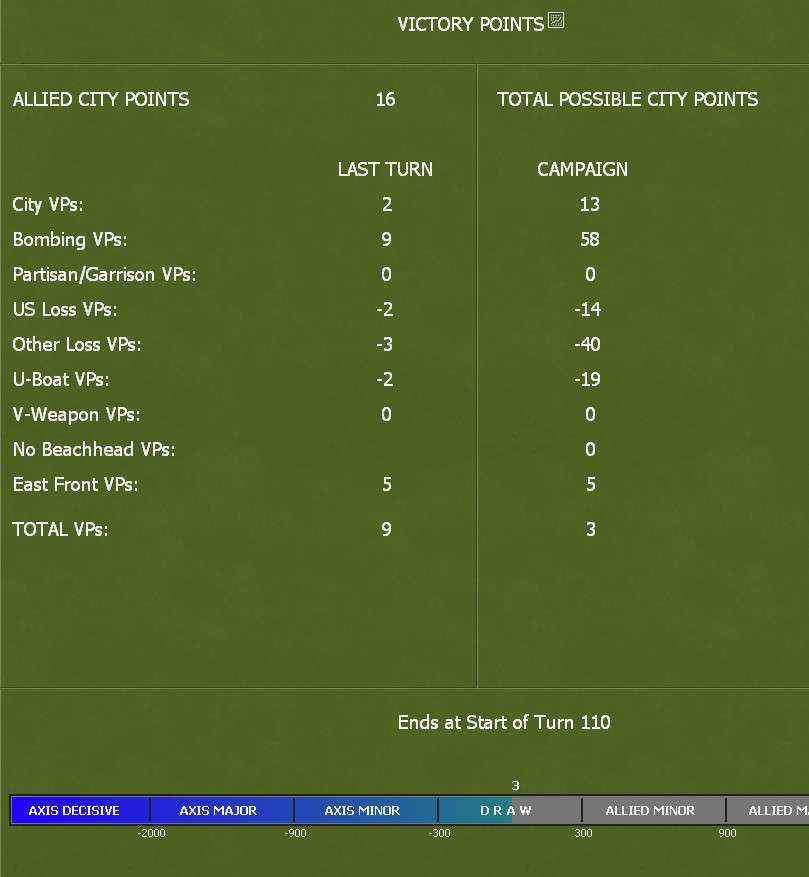
Decided to keep BC hitting the Ruhr. Logic is it does more damage here and still a lot of yellow targets – remember that for VP its manpower, HI, fuel and oil. The second mission is a two day raid around Cologne.

Shifted 8 AAF. Lots of targets in the Mainz-Frankfurt sector including some large truck plants.
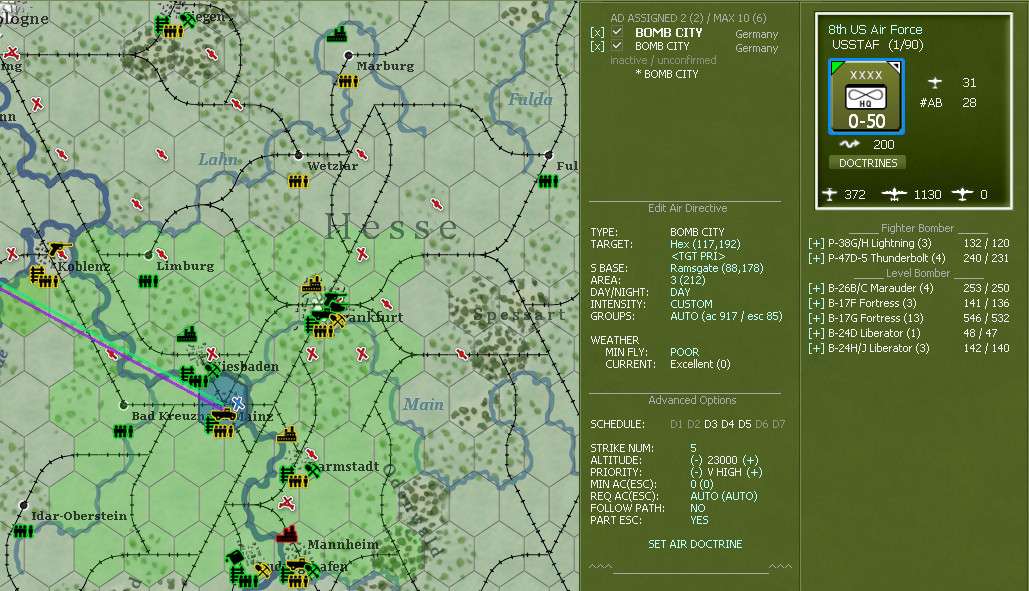
Still experimenting with the lighter bombers in the Tactical Air. Goal here is to hit the various fuel production sites along the coast and see if it can hit some manpower.

In the Med, carry on interdicting (naval and land) Messina, port bombing around Bari. Also going to invade Sardinia so set of missions designed to support the landings.
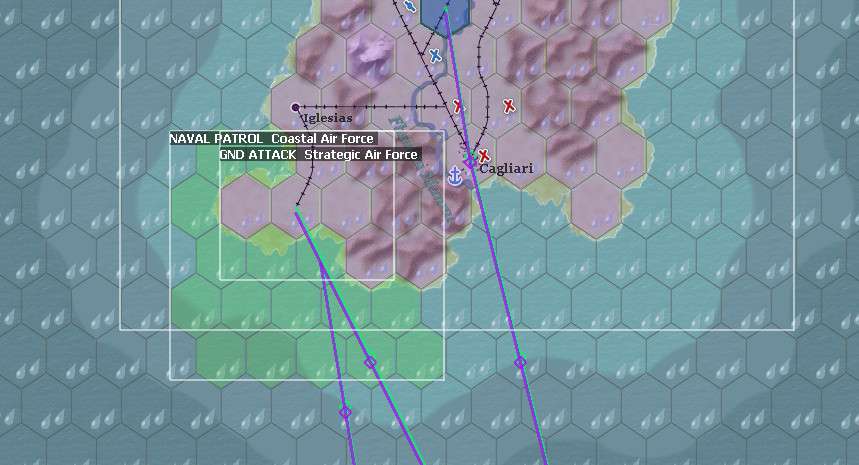
While we're in Italy ... Messina taken in heavy fighting.
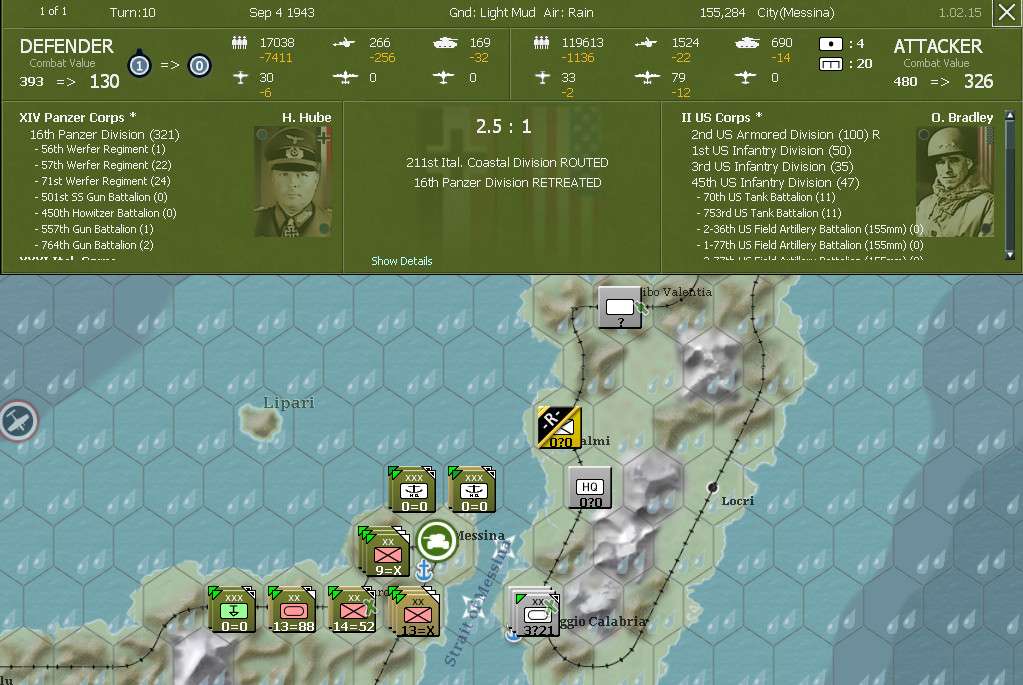
Main raids by Bomber Command. A lot of damage inflicted.
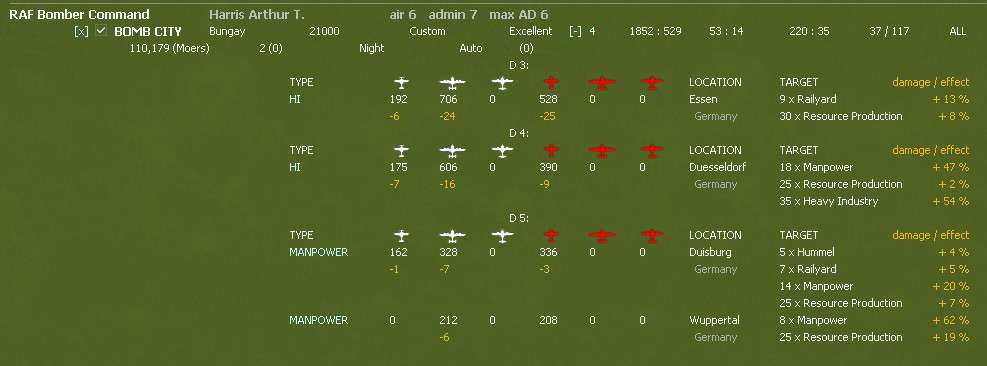
Secondary raid was effective too.

Fighter Command continues to inflict steady losses on the Germans. At that altitude the older Bf-109s really do suffer for performance.
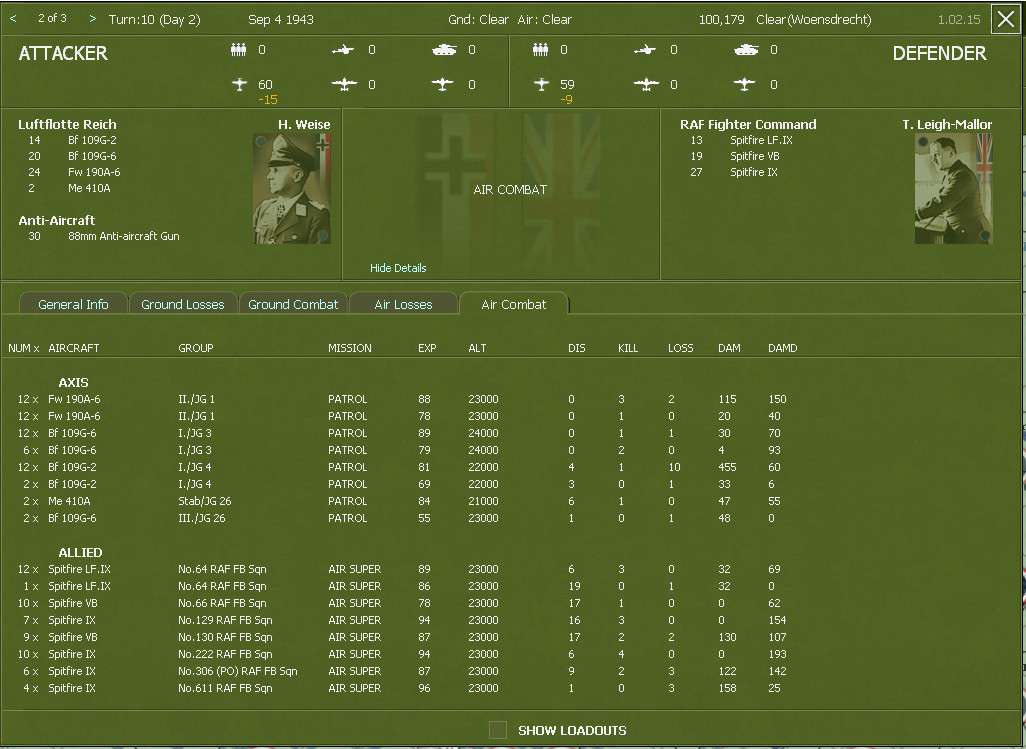
Tactical Air makes a small but useful contribution.

And 8 AAF produces a devastating raid on Mainz. Not only is the truck factory almost knocked out but lots of VP sites hit as well.
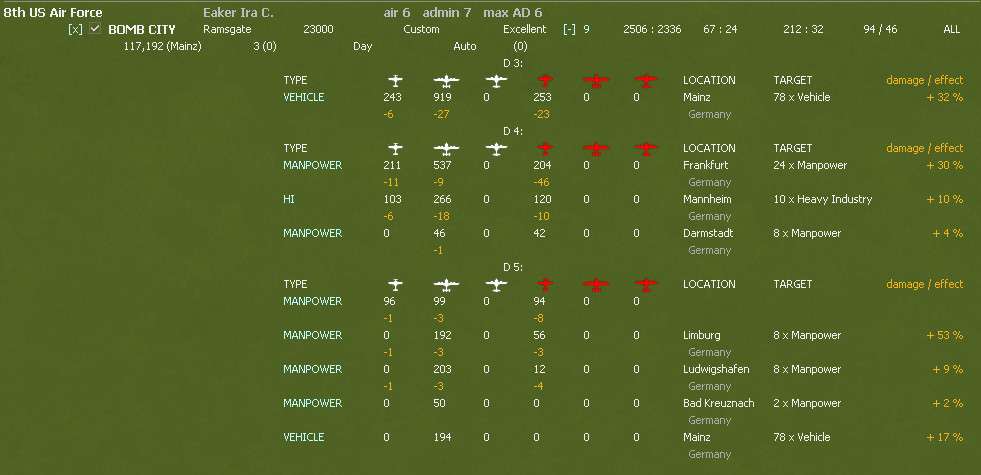
Its usual secondary raid on a U-boat plant does some damage too.

One thing that does seem to be working in this game is the combination of only using the strategic bombers 2-3 days a week and the 55 morale threshold. In the past I've tried for 4-5 days and used 65 and had periods where very little effort can be sustained and have had to accept lulls while the bombers recover.
This turn only had to rest 11 BC formations and 5 from 8 AAF.
VP situation. Bombing points slowly increasing and U-Boats back down to 2. More ground losses due to the Messina battles.

Decided to keep BC hitting the Ruhr. Logic is it does more damage here and still a lot of yellow targets – remember that for VP its manpower, HI, fuel and oil. The second mission is a two day raid around Cologne.

Shifted 8 AAF. Lots of targets in the Mainz-Frankfurt sector including some large truck plants.

Still experimenting with the lighter bombers in the Tactical Air. Goal here is to hit the various fuel production sites along the coast and see if it can hit some manpower.

In the Med, carry on interdicting (naval and land) Messina, port bombing around Bari. Also going to invade Sardinia so set of missions designed to support the landings.

While we're in Italy ... Messina taken in heavy fighting.

Main raids by Bomber Command. A lot of damage inflicted.

Secondary raid was effective too.

Fighter Command continues to inflict steady losses on the Germans. At that altitude the older Bf-109s really do suffer for performance.

Tactical Air makes a small but useful contribution.

And 8 AAF produces a devastating raid on Mainz. Not only is the truck factory almost knocked out but lots of VP sites hit as well.

Its usual secondary raid on a U-boat plant does some damage too.












